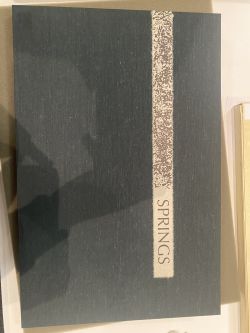Springs, An Artist Book By Enid Mark
You make italics like this.
You make bold text like this.
University of Pennsylvania's Kislak Center for Special Collections, Rare Books and Manuscripts

subsection 1
Here is how to make a footnote.[1]
subsection 1.a
subsection 2
- this
- is
- a
- bulleted
- list
subsection 3
Introduction

Springs is a limited edition artist's book created by Mark, Enid and published by the ELM Press in 1990. The book was made in Wallingford Pennsylvania, and features a series of hand-pulled lithographs printed from a combination of hand-drawn and photographic plates. This 11.5 x 36-inch book comprises of 10 pages, each page featuring a full-length image. Text is sparse, and can be found hidden within the pictures, title page, and front cover. The book is Mark's reflection of her visit to the Pollock-Krasner house. This particular copy is the second of only 25 signed copies by the author. It was acquired for the Penn Libraries with the assistance of Martin and Margy Meyerson Endowment Fund for Special Collections. Springs offers a unique creative experience, as it blends elements of Pollock's action painting with Mark's own artistic style.
Historical Context

Born in 1932, in New York City, Mark attended the High School of Music & Art in Manhattan and Smith College, where she studied English literature and studio art. In the early years of her career, she pursued painting and printmaking, and came to favor the technique of photolithography. As her career progressed, she began to gain the reputation of an adventurous bookmaker who explored many printing techniques. The texts of most of her books are works by contemporary American women poets. Each of Mark's books is devoted to a theme (such as travel, mythology, or botany). Mark selects poems that reflect that theme and develops images to complement those poems. She once wrote, “I imagine the book as a continuous picture plane on which word, image, sequence and structure all reinforce each other. What interests me most is the relationship between word and image. I plan no hierarchy of them. An artist’s book is a unique form of visual disclosure. It must be slowly savored. It should be held in the hand and carefully considered. Only then are its contents fully revealed.”
As seen on the credits page of the book, Mark was inspired by her visit to the Pollock-Kraser house, home to the late Jackson Pollock and his wife Lee Krasner. Jackson Pollock was an American Painter who was a leading figure of Abstract Expressionism, an art movement which began in the early 1940s, as artists sought new ways to express themselves and break away from traditional artistic styles. Best known for his unique style of drip painting, Pollock's work is characterized by his use of unconventional materials; such as using sticks, trowels, and knives to paint the canvas. He would often work at a large scale, such as using his whole body to create his paintings. This drip technique allowed Pollock to create complex layers of color and texture that were impossible to replicate with traditional brushstrokes.
Substrate Analysis
Innovation
Viewership
References
- ↑ Deidre Lynch, "Paper Slips: Album, Archiving, Accident," Studies in Romanticism 57, no. 1 (2018): 87-119.
- ↑ Jackson Pollock paintings, Bio, ideas. The Art Story. (n.d.). Retrieved May 3, 2023, from https://www.theartstory.org/artist/pollock-jackson/